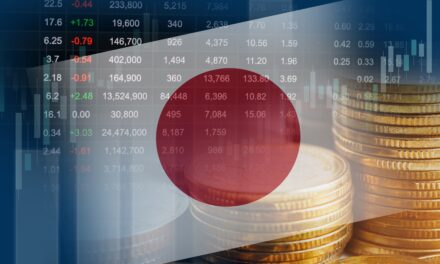Since Trump’s inauguration, I’ve remained cautiously optimistic about his handling of the economy and the impact he’d have on investments.
But the latest data from the job market points to serious pain headed our way in the second half … with April’s tariff turmoil serving as just the beginning of a tumultuous year.
Click below for the full story:
Video transcript:
Welcome to Moneyball Economics. I’m Andrew Zatlin, and we’re going to explore where we are with respect to being in the eye of this economic hurricane…
When I say eye of the hurricane, the first thing that should come to mind is this idea of a storm blowing in a period of calm, and then it’s followed by more turbulence, and that is exactly what I want you to think about. We are in an economic eye of the hurricane.
It started with Trump. He came blowing in, laying off hundreds of thousands of workers, cutting tens of billions of dollars from funds that go to the private sector and introducing tariffs, creating all this economic uncertainty. It’s going to result in higher inflation. It’s going to result in consumer spending pulling back, and it’s going to result in companies pulling back. But I mentioned that we’re in sort of an eye of the hurricane.
Why haven’t we seen it? Why do we have this period of calm? Well, two reasons really.
Reason number one, companies saw what was going on and they front ran it by buying months and months and months of extra inventory. They have stockpiled all this stuff on their shelves enough to buy them a few months of pre-tariff cost relief. So right now, and probably through June, most companies are able to continue to avoid raising prices because they’re still using products at yesterday’s cost, but by July, they can’t.
By July, they’re importing at today’s post tariff rates, and that is incredibly inflationary. In fact, that’s why Walmart already raised their hand and said, look, we’re going to have to raise prices because our costs are going up. But for now, inflation’s been tamed.
The second reason, well, it looks like the labor market’s just a little soft…
It looks like the economy’s okay, but in fact, that’s just because of how the government counts things. Let me give you an example because we’ve got to talk about this because it’s starting to pop up.
Severance packages, as I’ve shared many times, severance packages delay the point at which the government starts counting. That individual is no longer working. Let me say that again. You work for an IT company. You’ve been laid off in February, you’re one of the, what, 16,000 – 20,000 people who were given notices. But at the same time, you’re given some kind of 90 day package that says, look, don’t sue us. You accept that you’re no longer here. Here’s 90 days of pay. Well, the government says, well, that’s pay, pay is pay is pay, and so therefore we consider you A still employed, and B, unable to apply for jobless claims, and that’s why the jobs data has been so relatively strong or at least not weak.
However, that runs out and it runs out pretty much June and July because that’s when that 90 day period runs out. Why do I keep saying 90 days? Why do I say June?
Well, because the bulk of people who’ve been laid off who are not yet coming up in the jobless claims roles not yet reflected in payrolls coming down are white collar professionals. They are in the IT world. They’re in the healthcare, biotech, pharma world. That’s where a lot of the pain has been coming in.
For example, Donald Trump, the National Institute of Health, $48 billion annual budget, of which $35 billion goes to research grants to companies and to universities and so forth. By March, he’d cut $3 billion of spending. That’s by March, April, may.
There has been massive amounts of spending, now not going to white collar professional engaged jobs. They’re the ones who also get the severance packages, and so therefore they’re the ones who are no longer going to be working shortly.
When that severance package runs out, and that’s going to happen come June and July, that’s when you’re going to see a spike in jobless claims and when you’re going to see payrolls start to come down dramatically. But for now, in the eye of the hurricane, they’re not included in the data as it’s measured.
Well, guess what? Those measurements — laggy and delayed as they are — are going to catch up in a couple of months. That’s the turbulence we’re going to see, but guess what? We’re already seeing the real world implications of that.
I mentioned three data points.
We talked about interest rates going up. Well, interest rates are going up primarily not for economic reasons. Let’s face it. Interest rates go up when the economy’s pretty active, right? In this case, the economy’s not that active. Why are interest rates going up? Well, I believe that this is pure monetary gamesmanship.
The US dollar was super strong under Biden. Under Trump, it’s gotten weaker. The only way to get a weak dollar is if people aren’t buying dollars. If China and Japan had pulled back from buying dollars, and there are two reasons why that could be happening.
One is benign. Hey, we know Donald Trump is on the rampage. He wants a weak dollar to boost US exports. We will tolerate that by currency manipulation, letting the dollar get weaker, which moves interest rates up. The second reason is more malignant. You’re China, for example. You want to teach the US a lesson.
Rising interest rates is very problematic for an economy. It makes it more expensive to borrow. It slows the economy, and this is China perhaps saying, you know what? We don’t have to buy dollars. We can mess with you. I’m not sure which is going on, but suffice it to say higher interest rates are now here because we’ve got a weaker dollar, and that is a monetary issue, not a fiscal issue, and that is firmly in the Fed’s camp.
You know what? Interest rates going up, they’re not going to be cutting rates anytime soon, so I’m going to take off the table my projection that in June we’re going to see rate cuts. I’m not going to think we’re going to see it until September, and by then it’s going to be way too late because the economy is going to be slowing down the second half.
Why do I say that?
Data point number two, if interest rates are going up from here, that’s very problematic for the housing market, but guess what? They’ve already been high mortgage rates at 7% have already been slowing the housing market. We were in prime home buying season and this latest data said April. April home sales were the worst they’ve been since 2009.
Why? Well, because of all this economic uncertainty I’ve been saying Trump has got to pull a rabbit out of the hat by May.
People are very nervous.
The housing market is one third of our economy, so now you’ve got one third of our economy basically sitting on the sidelines. That’s recessionary.
That’s why we’re going to have a recession guaranteed in the second half, and again, going back to that severance package and the way jobs data gets measured, well, we have already laid off hundreds of thousands of people, even if it’s not yet fully in the data, but you take hundreds of thousands of people and you say “You don’t have a job,” guess what? Their spending slows down.
Those people are not going on vacations. Those people are not buying homes or not buying new refrigerators, so we have a strong wave that’s already hitting that is slowing down. Spending. Home Depot came out and they said, oh yeah, spending every year is up 1%. Home Depot big in the home buying market, right?
Wrong. Up 1% when you’ve had inflation of 3-4% means your actual sales are going down. In fact, they pointed the foot traffic and kind of acknowledged that people aren’t really doing big projects. You’re not seeing a lot of big stuff. That means big ticket items. Well, people aren’t buying them.
This economy is already starting to slow down. It’s just not showing up in the numbers, so that’s why I say either the hurricane followed by more turbulence, that more turbulence will start June and July, but I also see that third data point I mentioned. I see it already happening…
Massachusetts, this is obscure folks, but you need to pay attention. It’s canary in the coal mine time in the latest jobless claims data. I look at continuing claims as a good finger on the pulse of the economy. Generally speaking, if the economy is throwing out jobs, if it’s expanding, people don’t sit around saying, I haven’t had a job and I haven’t had a job for weeks.
That’s what continuing claims measure. People who have been out of work for two or more weeks, okay, it’s gone up. It’s gone up. In just the past four weeks, about 50,000 more people have raised their hand in the country and said, don’t have a job. Haven’t had a job in a while. That is problematic. It is a number that is substantial and will continue to rise.
Why? Well, because we’re starting to see the impact. You lay off hundreds of thousands of people. Eventually, they qualify for getting jobless claims. Now, the IT sector has been getting hit in general. I mentioned how Donald Trump through the NIH has been hitting the healthcare industry, the biotech, pharma, you name it, and guess who is especially exposed to that?
We’re talking about Massachusetts. When you think of Massachusetts, you should be thinking about Harvard, MIT, Boston University. In Boston alone, universities and colleges employ a hundred thousand people directly, faculty and staff.
Now, you add in all the economic drivers that those universities create because they’re spending billions of dollars in the local economy. There’s probably somewhere around 150,000-200,000 people who depend in Boston alone on those universities and not just universities. Now, factor in companies like Boston Scientific, all these IT companies, so you, you’re Donald Trump.
You’ve cut billions dollars from spending that goes directly to these universities. Then you’ve been on the attack against Harvard as well. You’ve cut billions of dollars there as well. As a result, layoffs are happening.
There’s an economic slowdown and that my friends, is what we’re suddenly seeing because that severance package issue, these are white collar professionals. They’ve been given a package. 90 days are now up. How do I know this is going on? Because that sudden spike in Massachusetts happened May 10th. Why is that material? Well, that’s the second week of the month.
Remember, to be part of the continuing claims to be part of this spike. You had to be out of work for two weeks. That meant you officially lost your job end of April. That’s a very tidy date that reflects company’s corporate world basically saying, we are going to pay you through the end of the month. After that, you’re on your own, and again, severance packages and so forth.
I believe we’re seeing the start of a wave.
Massachusetts is particularly vulnerable because of their dependencies on things like universities on money flowing into research grants and healthcare and on it, but this is something that’s going to go across the entire country.
June and July is when we’re going to start to see problems in the mainstream data, when we’re going to be exiting this eye of the hurricane and entering more turbulence. That means, again, we’re going to see massive volatility in the stock market.
I believe second half we have a guaranteed recession.
Maybe not deep, maybe shallow, but we are seeing massive problems in the second half. There are only two ways, this changes only two ways. One, Donald Trump pulls a rabbit out of the hat, signs some tariff deals. Now in May, that’s problematic because may is when people start to fold up. Tents that go on summer holidays, not a lot of buying happens then, except for the housing market.
In essence, consumer spending is going to be pulling back. If Donald Trump doesn’t come to the table with obvious relief on the tariffs, he’s blown the second half. Second possible rabbit out of the hat would be this new tax bill presenting It is a number one goal.
Why? Because Donald Trump wants to signal that he’s going to put more money in the pockets of households, that he’s going to give some tax relief that all of this turbulence that he’s created is finally paying off in the form of tax relief and possibly in addition, he might throw some money on the table that mythical $5,000 check that goes out.
Now he’s got to buy the consumers. He has to buy them now before they go on vacation, and unfortunately, time is definitely running out for this to happen. Very concerned about the second half. I do see this materializing as a recession, and so you should invest accordingly. You should be where luxury good makers, you should. I don’t think gold is going to rise any further.
I think it’s going to collapse because again, slowing consumer economy, it’s maybe as a flight to risk avoidance type of thing, flight to safety. But in general, I think gold’s going to be coming down. Let’s stay on top of this. We’ll see if Massachusetts is standalone or if indeed, over the next few weeks, we see other states start to reflect a softening jobs market. We’re in it to win it folks.
Zatlin out.

Andrew Zatlin
Editor, Moneyball Economics





